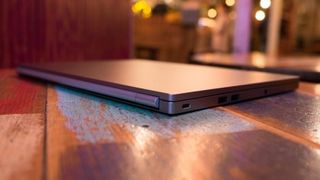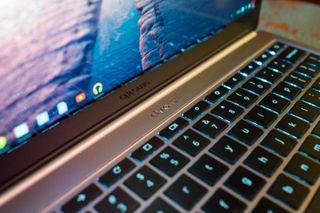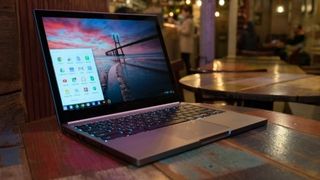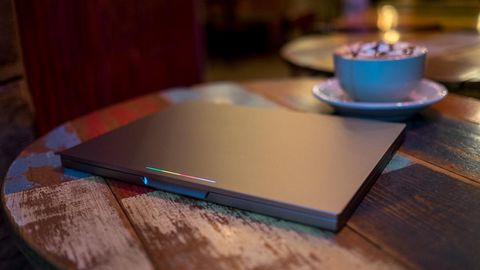Why you can trust TechRadar
The Pixel is by no means the lightest Chromebook around. It weighs in at 3.3 pounds (1.5 kg) largely thanks to its fully aluminum body, which measures in at 11.7 x 8.8 x 0.6 inches or 297 x 224 x 15 mm (W x D x H).
Despite it's unorthodox 12.5-inch screen, fitting the Pixel into a bag designed to carry 13- to 14-inch laptops is not a problem at all. What's more, the machine's shorter width (than most other laptops) allows me to slip in the charger right next to it inside the same laptop sleeve compartment.
By comparison, the Toshiba Chromebook 2 is lighter and ever so slightly thicker, at 2.95 pounds (1.33 kg) and 12.6 x 8.4 x 0.76 inches (320 x 213x 19.3 mm). The Acer Chromebook 13, meanwhile, weighs 3.31 pounds (1.5 kg) and measures 12.9 x 9 x 0.71 inches (327 x 228 x 18 mm).

Here is the Chromebook Pixel (2015) configuration given to TechRadar for review:
Spec Sheet
- CPU: 2.2GHz Intel Core i5-5200U (dual-core, 3MB cache, up to 2.7GHz with turbo boost)
- Graphics: Intel HD Graphics 5500
- RAM: 8GB DDR3
- Screen: 12.85-inch 2,560 x 1,700 IPS touchscreen display
- Storage: 32GB SSD
- Ports: 2 x USB-C, 2 x USB 2.0, headphone/mic jack SD card reader
- Connectivity: Intel Dual Band Wireless-AC 7260; Bluetooth 4.0 LE
- Camera: 720p HD wide angle camera with blue glass
- Weight: 3.3 pounds
- Size: 11.7 x 8.8 x 0.6 inches (W x D x H)
Starting at $999 or £799 (about AU$1,277), the Pixel comes at a steep premium compared to wide swath of affordable Chromebooks in the world, but you're also getting a beefed up configuration as seen above. Few Chromebooks come equipped with a beyond-HD screen let alone 32GB of SSD storage or 8GB of RAM by default. This is by far one of the fastest Chromebooks to ever ship, and you'll never run into a slow down, even after opening 20 or more Google Chrome tabs.
If that isn't enough speed for your liking, the Chromebook Pixel is available in an LS model, which stands for "Ludicrous Speed." The higher-end model retails for a baffling $1,299 or £999 (about AU$1,663), and it comes equipped with a 2.4GHz Intel Core i7 Broadwell processor, plus a bump up to 16GB of RAM and 64GB of storage.

If you're looking for something much lighter on your wallet, the Toshiba Chromebook 2 is available for $329 (about £223, AU$431). It's not quite as well equipped as the Pixel, but the Toshiba machine comes outfitted with a gorgeous 1080p screen and a more than adequate 2.16GHz Intel Celeron processor.
The Acer Chromebook 13 is by far the most affordable option of this trio. Priced at $249 or £219 (about AU$326), it comes packing a full HD display and a 2.1GHz Nvidia Tegra K1 for the CPU.
Performance
The Pixel is a wickedly fast machine. Web pages load up lighting quick, scrolling is smooth and even pinch to zoom on the touchscreen feels snappy. Sure, you're pretty much limited to only web surfing on Chromebooks, but even mid-range laptops can stumble with just running the browser. In many ways, using the Pixel feels a lot like a fully decked-out gaming laptop, because it is so consistently fast - just don't expect it to run many games.
Powered by a Core i5 processor and 8GB of RAM, the machine truly comes into its own when streaming 1080p and even 4K video on YouTube. Most Chromebooks do perfectly well with full HD footage, but higher-res video has made most machines buckle, whereas the Pixel ran smoothly. I was even able to play Bastion without a hitch, unlike the Celeron-powered Toshiba Chromebook 2, thanks to the headier Intel HD 5500 integrated graphics.

Getting over that blocky screen
Aside from the Pixel's hefty price tag, one thing you'll have to get over is its 3:2 aspect ratio. The display is a bit taller than most other laptops, and this makes it great for working documents, the little photo editing you can do in Photoshop, as well as viewing web pages.
Of course, you'll probably only be looking at a single window at a time. Thanks to the screen's narrower width, having two windows side by side gets uncomfortably cramped. Thick black bars at the top and bottom of the display are also an unavoidable issue when watching movies or any media made for widescreens.
But, if you can get over these annoyances of having a 3:2 screen, the Chromebook Pixel has one of the nicest looking displays. The panels is nice and bright: even with the backlight set to 50%: it's easy to see everything on the display, even in bright sunlight. Colors are also rich, and there's plenty of contrast to fully appreciate whites fading into subtle grays and then deep blacks.
Google has even fine tuned the touchscreen's responsiveness and accuracy. That said, I rarely found myself playing around with it other than to pinch and zoom in on a few webpage images.

Beyond all day use
Google boasts the its new Chromebook Pixel has a battery life of 12 hours, and that estimate isn't too far off from the reality. In my own testing, I was able to eke out 8 hours and 22 minutes of usage. During my test, I set the screen brightness to 50% while I tabbed between 20 webpages, listened to Google music and, to top it all off, I streamed a two-hour movie on Netflix.
Nearly nine hours of battery life would be a huge number for any Chromebook, but it's even more impressive because of the Pixel's Core i5 processor and high-resolution screen. With most Windows laptops, a high-resolution screen can shortens battery life by three hours or more.
Although the Toshiba's Chrome OS machine comes sporting lower resolution full-HD display, it only lasted 6 hours and 26 minutes. The Acer Chromebook 13, meanwhile, managed to edge out its competition with a screen-on time of 8 hours and 56 minutes, largely due to its power-sipping Tegra K1 processor.
Kevin Lee was a former computing reporter at TechRadar. Kevin is now the SEO Updates Editor at IGN based in New York. He handles all of the best of tech buying guides while also dipping his hand in the entertainment and games evergreen content. Kevin has over eight years of experience in the tech and games publications with previous bylines at Polygon, PC World, and more. Outside of work, Kevin is major movie buff of cult and bad films. He also regularly plays flight & space sim and racing games. IRL he's a fan of archery, axe throwing, and board games.


